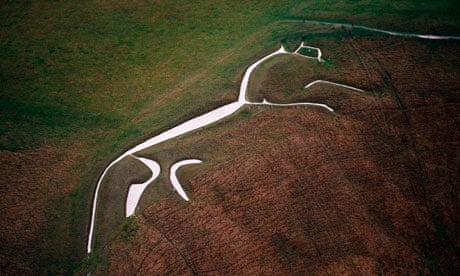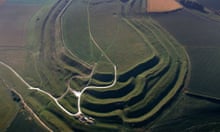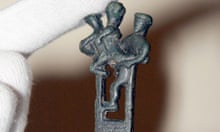It is one of Britain's most-loved ancient hill figures, careering across the downland. Now vets are being urged to question whether the White Horse of Uffington was meant to be a horse at all.
Challenging the traditional description of the Oxfordshire landmark, retired vet Olaf Swarbrick asks whether the "beautiful, stylised" figure might instead be a dog such as a greyhound or wolfhound.
In a letter to the Veterinary Record, his profession's journal, the former cattle and poultry specialist suggests a canine origin for the 110-metre by 38.5-metre animal, which was carefully dug into the downland. He invites alternative theories, too.
Swarbrick says: "Looking at it again, it seems that it is not a horse at all: the tail and head are wrong for a horse and more suggestive of a dog. It appears more like a large hound at full stretch. I thought it may be a greyhound, but an anthropologist suggests it is a wolfhound, which (assuming it is not a horse) makes more sense."
The horse, if it is one, is about 3,000 years old, dating from 1250-850BC if most recent theories are correct. It was earlier believed to have Anglo-Saxon origins, and perhaps to be a memorial to King Alfred's victories over the Danes in the ninth century AD. Doubts over its equine origin have been aired before but written records suggest the hill on whose slopes it gallops has been named after the white horse since at least the 11th century.
Swarbrick told the Guardian: "I was just saying it was not a horse which will perhaps infuriate some archaeologists." If colleagues agreed with him, "quite a lot of people, including the Ordnance Survey, will have to change their terminology".
He added that other horse hill figures in Britain were "quite clearly horses", even if more recent than the Uffington one. And the Long Man of Wilmington in Sussex and Cerne Abbas giant in Dorset were clearly human.
Keith Blaxhall, the National Trust warden for the area, was not convinced. "I think we all think it is a horse," he said, adding that coins from roughly the same period show a similar stylised horse and chariot. "Horses were enormously important. It signified power. You were mobile.
"I have always called it a he, for some reason. There is no 'stallion effect' to it but it is a very proud and powerful symbol on the landscape." There had been claims it might be St George's white charger, he said, but the figure long predated his era. The dog suggestion was new to him. "I have really only heard the theory it is feline because of its sinuous design."
Blaxhall was unworried by the site's equine symbolism being doubted. "It is different things to different people. Who is really to know? It is prehistory. No one wrote anything down. It is just a magical place and people are drawn to it."






Comments (…)
Sign in or create your Guardian account to join the discussion